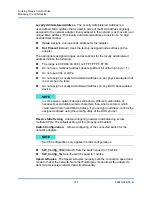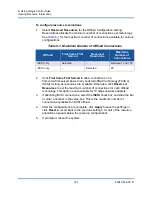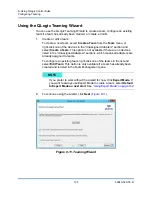
8–Using QLogic Control Suite
Managing the LAN Device
120
83840-546-00 D
If the risk above is not desirable and filtering of VLAN ID membership is
required, then support through an intermediate driver would be necessary.
Receive Side Scaling
Allows enabling of RSS queues.
Interrupt Moderation
Enables interrupt moderation, which limits the rate of
interrupt to the CPU during packet transmission and packet reception. The
disabled option allows one interrupt for every packet transmission and packet
reception. Enable is the default option.
Maximum Number of RSS Queues
Configures the number of VMQs or RSS
queues. The queue options are 2, 4, 8 (default), and 16.
Receive Buffers (0=Auto)
The number of receive buffers. Receive buffers are
data segments that allow the network adapter to allocate receive packets to
memory. The range of valid receive buffers is 0 to 3000 in increments of 50 with
automatic (0) assignment of receive buffers as the default value.
Transmit Buffers (0=Auto)
The number of transmit buffers. Transmit buffers
are data segments that allow the network adapter to monitor transmit packets in
the system memory. The range of valid transmit buffers is 0 to 5000 in increments
of 1 with 250 transmit buffers as the default value.
Pause on Exhausted Host Ring
For 8400/3400 Series network adapters, there
are two possible scenarios that can trigger pause frames to be generated: a host
ring buffer is exhausted or the on-chip buffers are depleted. With RSS enabled
inside the system, it is possible to achieve better Ethernet throughput if no pause
frames are being generated in a case where a host ring buffer (of multiple RSS
rings) is exhausted. The default is Disabled.
Quality of Service
Enables Quality of Service (QoS) to provide different
priorities to different applications. When QoS is enabled, administrative control
over DCB-related settings is relinquished to the Windows Server 2012/2012R2
operating system QoS service (that is, QCS can no longer be used for
administrative control of the DCB). The QoS service configuration should be
comparable with the incoming switch DCBX settings to ensure that the designated
traffic types are treated the same on the switch as through the QoS service. By
default, the adapter is set to DCBX Willing mode, which means that the incoming
switch DCBX settings take precedence over the Server QoS service settings if the
two are not comparable. To revert to standard QCS control over the QLogic DCB
feature set, uninstall the Microsoft QoS service feature (entire host) or disable
Quality of Service in the NDIS advance properties page (per port).
Recv Segment Coalescing (IPv4)
Enable Receive Segment Coalescing (IPv4).
Receive Segment Coalescing is an offload technology that reduces CPU use for
network processing on the receive side by offloading tasks from the CPU to a
network adapter.
Summary of Contents for 8400 Series
Page 390: ......
















































